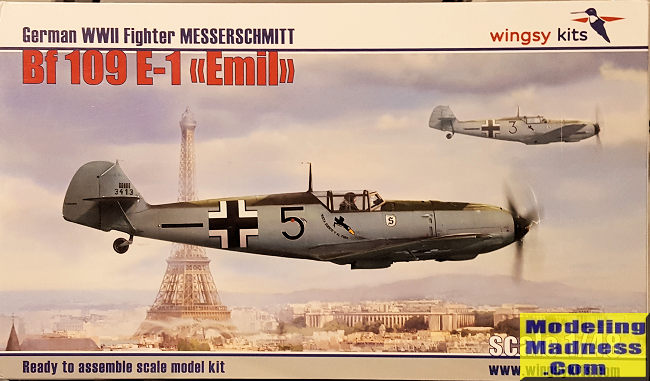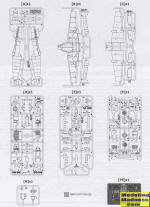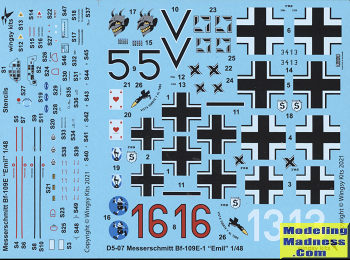
| KIT #: | P72132 |
| PRICE: | $51.55 delivered from Kyiv |
| DECALS: | Four options |
| REVIEWER: | Scott Van Aken |
| NOTES: |
2021 New tool kit |

| HISTORY |
| THE KIT |
 I've always liked the 109 and when I read Tom
Cleaver's review, I thought it would be nice to have one. Since one wasn't sent
to me, I put in an order from a shop in Ukraine and ten days later it was at my
door.
I've always liked the 109 and when I read Tom
Cleaver's review, I thought it would be nice to have one. Since one wasn't sent
to me, I put in an order from a shop in Ukraine and ten days later it was at my
door.
It comes in what seems to be the standard for kits from Ukraine in that it has a 'lunch box' style main cardboard box with a thin card upper box top. Inside there is room for three kits. Half of the dark grey sprues are in one zip bag with the other in another. There is also a small bag for the clear bits, and one for the photo etch fret. A set of canopy masks is included. Photo etch is used for small items like rudder pedal straps, control levers, head armor, coolant radiator splitter, rudder actuator, upper and lower exhaust deflectors, radiator exhaust doors, and the seat harness.
The cockpit is nicely detailed and makes into a module that, like other 109 kits, can be inserted into the fuselage from the underside. There is an upper cowling piece that goes all the way back to the start of the windscreen. The upper cockpit decking is also a piece that includes the bit that goes behind the seat. Gear wells are separate and are two pieces per side. Lower cowling is also a separate bit and includes the oil radiator mount. Wing radiators are seven pieces per side. You have a choice of whether to install the tail gear opening or not, though no markings option uses this.
Slats, flaps, ailerons, elevators and rudder are all separate pieces, though if you install the rudder actuator piece, you have to keep it at the neutral position. Also separate is the canopy section which can be posed open. As a note, most Bf-109E-1s did not have head armor until mid-1940 so if you don't want to deal with four pieces of photo etch, you can leave it off if you do an early version.
 Instructions are in 'road map' format which works well for many. Color information is provided during the build using Gunze color references. Four markings options are provided. Two are in RLM 70/71/65 splinter scheme with one being flown by 'Pips' Priller in 1939 with I./JG 51. The other was flown
by Heinz Bar in late 1939 while also with I./JG 51. The other two are in the
later RLM 71/02/65 scheme with no mottling. One was flown by Fritz Losigkeit with II./JG 26 in Germany during 1940. The other was flown by Hans Krug of 5./JG 26 in during the battle for France in 1940. The decal sheet is nicely printed and includes instrument panel decals.
Instructions are in 'road map' format which works well for many. Color information is provided during the build using Gunze color references. Four markings options are provided. Two are in RLM 70/71/65 splinter scheme with one being flown by 'Pips' Priller in 1939 with I./JG 51. The other was flown
by Heinz Bar in late 1939 while also with I./JG 51. The other two are in the
later RLM 71/02/65 scheme with no mottling. One was flown by Fritz Losigkeit with II./JG 26 in Germany during 1940. The other was flown by Hans Krug of 5./JG 26 in during the battle for France in 1940. The decal sheet is nicely printed and includes instrument panel decals.
| CONCLUSIONS |
Since this is the new 'golden boy' on the market, it has gotten a lot of hype. It does look like a nice kit, though the inclusion of photo etch along with a lot of separate parts where other kits use one, means it has the opportunity to be fiddly. This is, however, just an initial impression and one cannot tell about any kit until one builds it. I look forward to the opportunity.
| REFERENCES |
https://en.wikipedia.org/wiki/Messerschmitt_Bf_109_variants
July 2021
Copyright ModelingMadness.com. All rights reserved. No reproduction in part or in whole without express permission.
If you would like your product reviewed fairly and fairly quickly, please contact the editor or see other details in the Note to Contributors.